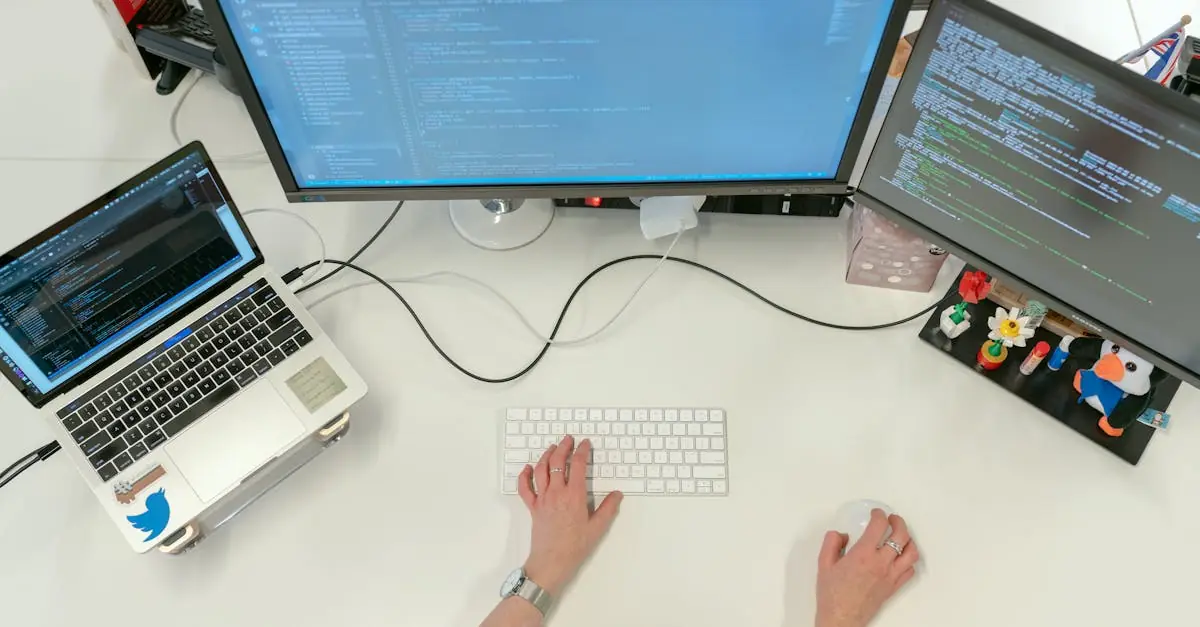In the ever-evolving world of technology, software engineering stands as the backbone of innovation. It’s not just about writing code; it’s about solving problems, creating experiences, and sometimes, battling the occasional bug that seems to have a vendetta. With so many types of software engineering, it can feel like navigating a buffet where every dish looks delicious but you’re not quite sure what to choose.
Table of Contents
ToggleOverview of Software Engineering
Software engineering encompasses a broad range of disciplines, each focusing on specific aspects of software development. This multifaceted field includes areas like systems engineering, applications development, and quality assurance. Understanding the different types helps streamline project management and improve outcomes.
Applications development specializes in creating software applications for end users. This can range from mobile apps to desktop software. Systems engineering focuses on the design and integration of complex systems, ensuring all components work together effectively. Quality assurance emphasizes testing and validation, guaranteeing software meets specified requirements before release.
Embedded software engineering targets specialized computing systems within larger devices. These systems operate within constraints and require precise programming skills. Meanwhile, web development focuses on the creation and maintenance of websites, integrating back-end processes with user interfaces.
Game development offers an exciting niche, combining software engineering with graphic design and storytelling. This area requires knowledge of specialized programming languages and frameworks to enhance user engagement. Furthermore, DevOps unites software development and IT operations, emphasizing collaboration and efficiency in delivering software updates.
Data engineering involves managing and processing vast data sets, ensuring availability for analysis. This area often collaborates with data scientists to develop algorithms and maintain databases. The varying types of software engineering create diverse roles, catering to an array of skills and interests within the tech industry.
Types of Software Engineering
Software engineering includes various specializations, each addressing specific challenges in the tech landscape. Below are key types of software engineering disciplines.
Front-End Development
Front-end development focuses on creating the visual elements of a website or application. This role emphasizes user experience and involves utilizing technologies like HTML, CSS, and JavaScript. Designers and developers collaborate closely to ensure that interfaces are not only aesthetically pleasing but also functional. They prioritize responsive design to accommodate various screen sizes, fostering accessibility for all users. Engagement and interactivity drive the design process, enhancing user satisfaction.
Back-End Development
Back-end development involves managing server-side logic and database interactions. This aspect of software engineering requires proficiency in languages such as Python, Java, or Ruby. Developers design and maintain the infrastructure that supports applications, ensuring seamless data flow and security. They also work with APIs to connect front-end interfaces with back-end services. Performance optimization and scalability remain crucial considerations, as they directly affect user experience.
Full-Stack Development
Full-stack development combines both front-end and back-end development. Professionals in this role possess a comprehensive skill set, allowing them to manage an entire application from layout to database management. Knowing multiple programming languages and frameworks enables these developers to create cohesive and integrated experiences. They streamline the development process by bridging gaps between teams. Collaboration is vital, as full-stack developers often serve as versatile problem-solvers within projects.
DevOps Engineering
DevOps engineering merges development and operations to enhance software delivery and infrastructure management. This approach emphasizes continuous integration and continuous deployment (CI/CD), allowing for rapid iteration and feedback. Automation plays a significant role, with engineers utilizing tools like Docker and Kubernetes for efficient deployment. They promote collaboration between development and operations teams to foster a culture of shared responsibility. Monitoring and maintenance strategies ensure application reliability and performance.
Software Engineering Methodologies
Software engineering methodologies guide the development process, shaping how teams build software. Various methodologies exist, with Agile and Waterfall being two prominent examples.
Agile Methodology
Agile methodology prioritizes flexibility and collaboration. It organizes work into small increments known as sprints, allowing teams to adapt to changing requirements quickly. Daily stand-up meetings enhance communication and facilitate rapid decision-making. Developers focus on delivering functional software regularly, fostering continuous improvement. User feedback plays a crucial role, steering future iterations. Overall, Agile promotes an iterative approach, ensuring products evolve based on real user needs.
Waterfall Methodology
Waterfall methodology follows a linear and sequential approach. Each stage, like requirements gathering, design, development, testing, and maintenance, must be completed before moving to the next. This structure makes project timelines predictable and helps maintain strict deadlines. Changes during the development phase can be challenging due to the rigid flow, but careful planning mitigates potential issues. Waterfall is best suited for projects with clear, fixed requirements where changes are minimal. Overall, this methodology emphasizes thorough documentation and structured phases.
Trends in Software Engineering
Software engineering continuously evolves to meet emerging technology demands and user needs. The rise of artificial intelligence (AI) and machine learning (ML) impacts software development processes significantly. Teams increasingly integrate AI solutions to enhance automation, making coding faster and less error-prone.
Cloud computing also plays a crucial role in shaping trends. It enables scalable infrastructure, allowing developers to deploy applications more efficiently. The shift towards cloud infrastructure facilitates remote work, making collaboration more straightforward for distributed teams.
Another noticeable trend is the growing focus on cybersecurity. With the increase in cyber threats, developers prioritize security measures throughout the software development life cycle. By implementing security practices from the beginning, they ensure that applications remain robust against potential attacks.
Microservices architecture has gained popularity as well. This approach breaks applications into smaller, independent services, enhancing flexibility and scalability. Developers can deploy updates more frequently without affecting the entire system, which results in improved software responsiveness.
Additionally, an emphasis on user experience (UX) remains strong. Engineers invest in research and design to deliver applications that cater to users’ needs. As a result, intuitive interfaces and smooth navigation are critical elements in software development.
Sustainability also emerges as a factor influencing software engineering practices. Companies explore eco-friendly coding practices to reduce energy consumption and improve resource efficiency. By adopting such practices, they contribute to environmental protection while driving innovation.
These trends illustrate the dynamic nature of the software engineering field. Adaptation to these developments ensures that engineers remain competitive and relevant in an ever-changing technology landscape.
The landscape of software engineering is as diverse as it is dynamic. Each type of software engineering plays a crucial role in shaping how technology meets user needs and addresses complex challenges. As the industry evolves with trends like AI, cloud computing, and sustainability, engineers must stay agile and informed.
By understanding the various disciplines and methodologies, professionals can better position themselves for success and innovation. Embracing these diverse areas not only enhances individual skill sets but also contributes to the collective advancement of technology. The future of software engineering promises exciting opportunities for those willing to adapt and grow.





